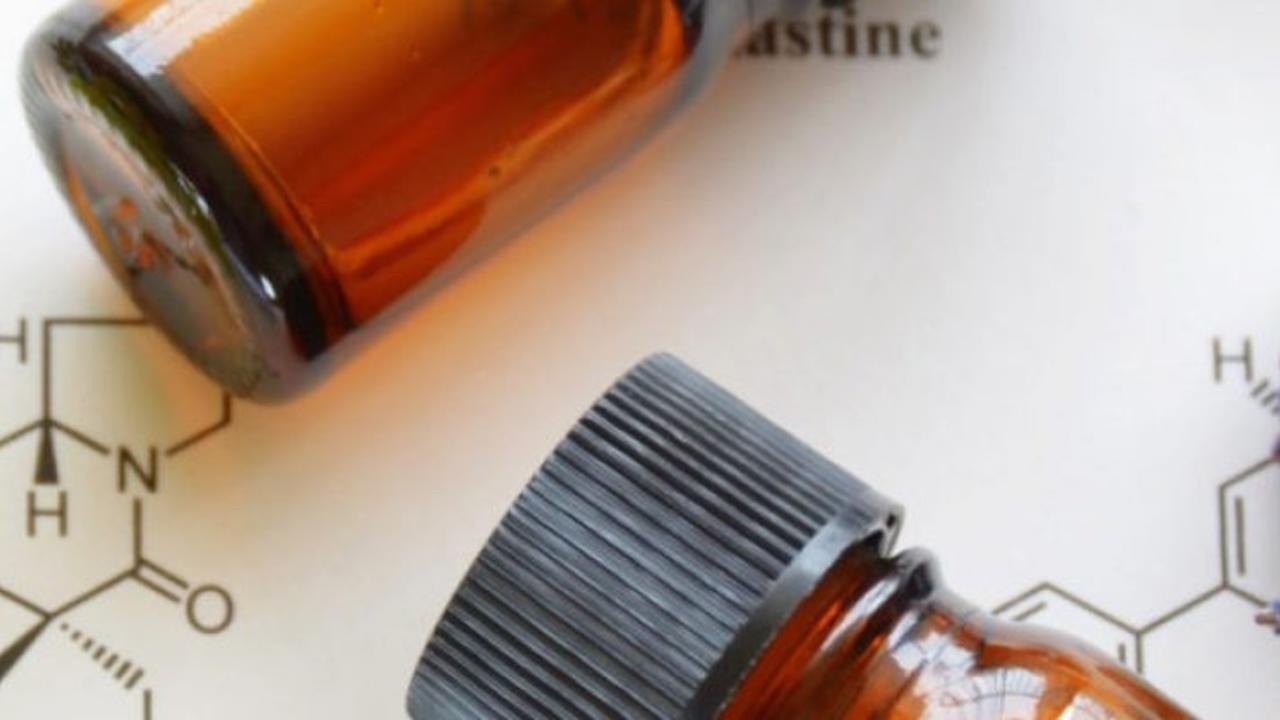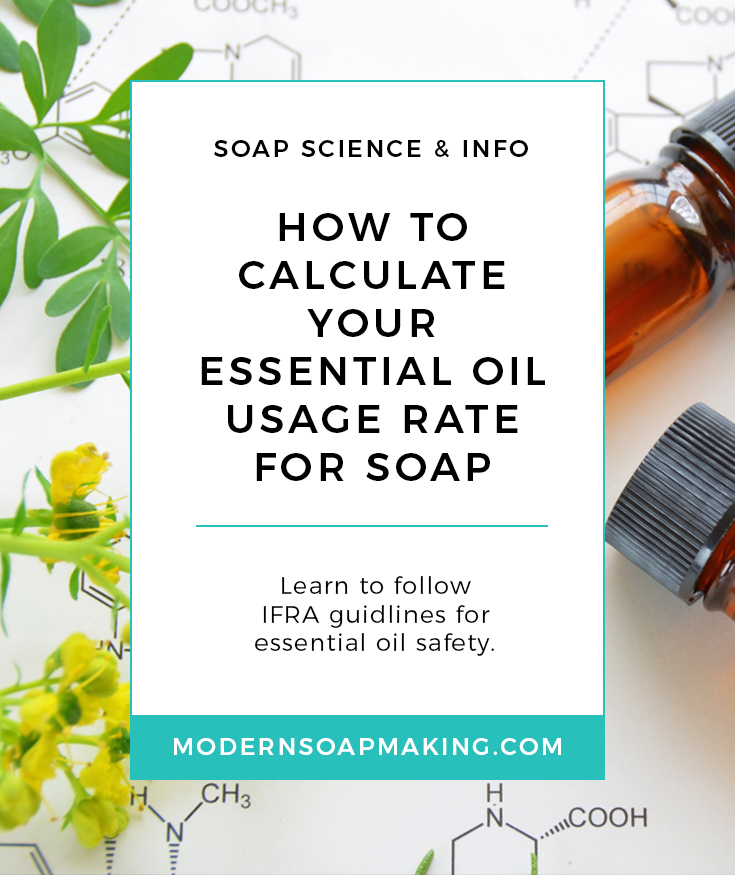How Much Essential Oil To Put In Soap

How to Stop Guessing at the Essential Oil Usage Charge per unit When You Make Lather
At present that I've dished on my top ten recommended essential oils for soapmaking, I want to dig into the age old question of:
How practise I effigy out the usage charge per unit of XYZ essential oil? How much essential oil practice I use in soapmaking?
Unfortunately, this is never a straightforward answer, simply allow's decipher the in's and out'due south of essential oil usage rates in soapmaking!

Converting your essential oil usage rates from percentage to weight
For most cosmetics formulating, fragrances are used at a rate of 0.5% to 5% of the total formula: less for leave-on products, more for wash-off products, and even more than for non-pare contact products.
As cold process soap is a launder-off product, the standard essential oil usage rate falls in the mid-range. I mostly utilize an essential oil usage charge per unit of 2% to 4% of my soaping oils.
For example, if your soap mold holds roughly 4 oz of oil per cavity (giving you 4.75 oz bars of soap), a 3% usage rate would be found similar so:
4 oz x 0.03 (three%) = 0.12 ounces or roughly 3.five grams of essential oil
Observe how the essential oil usage rate is calculated from the oil of the formula, and not from the total. Why is that? In soapmaking, nosotros utilise h2o (or other liquids) equally a carrier for the sodium hydroxide (lye) to consummate saponification. After saponification is consummate, the h2o mostly evaporates from the formula during cure. If yous calculate your essential oil usage rate based on the full formula, information technology will get more concentrated during cure - not skillful!
As a side note: I take never used drops for anything as they are highly inaccurate and vary so widely (big drops, little drops, oops, an extra driblet, etc.). I ever weigh my ingredients, including my essential oils, in soapmaking - no drop, cups, or guessing!
Where this gets complicated with essential oil usage rates is that each individual essential oil poses its own unique challenges, guidelines and needs, due to possible skin irritation, sensitization, photosensitivity, and performance in soapmaking. Some essential oils have a lower recommended usage charge per unit than others due to these bug.
Personal preference plays a part in deciding how much essential oil to utilise
Here are my personalmaximum essential oil usage rate guidelines for soapmaking:
| Essential Oil | Per Pound of Oils | Pct of Oils |
|---|---|---|
| Amyris | 0.40 ounces PPO | 2.fifty% |
| Anise | 0.15 ounces PPO | 0.94% |
| Basil (Sweet) | 0.30 ounces PPO | 1.88% |
| Bergamot (Bergaptene Gratuitous) | 0.70 ounces PPO | four.38% |
| Black Pepper | 0.08 ounces PPO | 0.fifty% |
| Cedarwood | 0.l ounces PPO | 3.13% |
| Cinnamon Leaf | 0.08 ounces PPO | 0.50% |
| Citronella | 0.50 ounces PPO | 3.xiii% |
| Clary Sage | 0.50 ounces PPO | 3.13% |
| Clove Bud | 0.08 ounces PPO | 0.50% |
| Eucalyptus (Globulus) | 0.50 ounces PPO | 3.13% |
| Fir | 0.70 ounces PPO | iv.38% |
| Geranium | 0.50 ounces PPO | three.13% |
| Ginger | 0.30 ounces PPO | 1.88% |
| Grapefruit (Cold Pressed) | 0.eighty ounces PPO | 5.00% |
| Lavender 40/42 | 0.lxxx ounces PPO | 5.00% |
| Lemon (Cold Pressed) | 0.80 ounces PPO | 5.00% |
| Lemongrass | 0.80 ounces PPO | 5.00% |
| Lime (Cold Pressed) | 0.lxxx ounces PPO | 5.00% |
| Litsea Cubeba | 0.70 ounces PPO | 4.38% |
| Orangish (Sweet) | 0.fourscore ounces PPO | 5.00% |
| Orange (Folded) | 0.50 ounces PPO | 3.13% |
| Palmarosa | 0.40 ounces PPO | two.50% |
| Patchouli | 0.50 ounces PPO | 3.13% |
| Peppermint | 0.40 ounces PPO | ii.50% |
| Peru Balsam (Distilled) | 0.15 ounces PPO | 0.94% |
| Petitgrain | 0.50 ounces PPO | three.13% |
| Pino | 0.40 ounces PPO | ii.50% |
| Rosemary | 0.l ounces PPO | 3.13% |
| Spearmint | 0.xxx ounces PPO | one.88% |
| Tea Tree | 0.50 ounces PPO | 3.xiii% |
| Vetiver | 0.thirty ounces PPO | i.88% |
| Ylang Ylang (Complete) | 0.forty ounces PPO | 2.50% |
If you want to apply an essential oil with a low usage rate, yous tin can pair it with essential oils that have a higher usage rates. For example, creating a alloy containing clove bud essential oil and patchouli essential oil together, which gives you lot a total of 0.58 ounces maximum (0.five oz ppo patchouli, 0.08 oz ppo clove.) Your combined essential oil usage charge per unit (the total sum of all essential oils) should not reach over 0.viii ounce to 1 ounce per pound of oils (5% to 6.25% of the oils.)
Each of these maximum essential oil usage rates for soapmaking were pulled from my personal reference sheet, calculated based on experience, strength of scent, and standards compliance. I prefer my products scented in a mild to moderate amount, so y'all may choose to apply a higher essential oil usage charge per unit based on your preference.
I briefly checked each essential oil usage rate against current IFRA Standards (48th Amendment) using my personal stock of essential oils and their specific data to the best of my ability. (I'm not perfect and will add any corrections equally necessary, please go on reading to learn how to check the standards yourself!)
Wait, what are IFRA Standards?
Yessum, there is yet some other layer to calculating your essential oil usage charge per unit! The International Fragrance Association (IFRA) Standards work to regulate the safety utilize of fragrance materials that are peel sensitizers and irritants.
The International Fragrance Association establishes guidelines for safe usage, and works with the Research Found for Fragrance Materials (RIFM) to make up one's mind these guidelines based on scientific analysis rather than unconfirmed reporting or speculation.
This is starting to audio complicated, right? To make safe essential oil usage rate info more attainable to to the soapmaking customs, I've created the EOCalc. With this tool, you tin summate rubber usage charge per unit for your own essential oil blends or you can explore fragrance blends from my personal formulary and submissions from our grouping. Bank check out everything to EOCalc tin can do for y'all!
Compliance with the IFRA standard are on a volunteer basis but are recommended. While membership of the IFRA is normally out of accomplish for white cottage manufacturers (such every bit you lot and I), the standards and practices recommended by the IFRA are open up for public viewing and understanding.
The IFRA Lawmaking of Practice and the IFRA Standards Booklet are available on IFRA's website: http://www.ifraorg.org
Iii IFRA Standards classifications effect essential oil usage rates
- Prohibited means that yous should not use the ingredient at all.
- Restricted means that you tin can apply the ingredient, however, it should but be used below a sure concentration level.
- Specification means that yous should evaluate purity criteria.
IFRA Product Categories also make up one's mind essential oil usage rates
And there are eleven categories of product types that are used to determine safe usage rates, they are equally follows:
- Category 1: Lip Products, such as lipstick, lip balm, lip scrubs
- Category 2: Deodorant and antiperspirants
- Category iii: Hydro-alcoholics for Shaved Pare, which include eye products, men's facial care products, and products for children or infants
- Category 4: Hydro-alcoholics for Unshaved Peel, which include some hair products, body mists, torso lotions, body oils, foot care products, and fragrance ingredients in cosmetics and perfumery kits
- Category 5: Facial care products, facial masks, hand cream products, dry out shampoo, and permanent pilus products
- Category 6: Mouthwash, toothpaste, or sprays
- Category seven: Insect Repellents
- Category eight: Makeup remover, hair styling aids, nail care products, and whatsoever powder or talc products
- Category 9: Wash-off products such as lather, bath gels, trunk washes, shampoo, conditioner, liquid soap, or shaving cream
- Category ten: Laundry detergent, fabric softener, and household cleaning products
- Category 11: Non-pare contact products that may come up in contact with skin, such as air fresheners, candles, and reed diffusers
Earlier using any essential oil in whatsoever production formulation, you should check the IFRA Standards for compliance on usage rates in specific product types. Unfortunately, this is condign more difficult for the less knowledgeable formulator as many of the standards have shifted to list by specific constituent rather than the complete essential oil. (That'due south why I created the EOCalc to aid soapmakers at every level.)
For example, cinnamon foliage essential oil is a restricted material due to its eugenol content. In order to comply with the IFRA Standards, yous must know the eugenol content of your cinnamon leaf essential oil to determine the safe usage rate in your product category (if it's lather, that'due south category 9 and the max eugenol content is 0.5% currently). The eugenol content of your essential oil can exist found on either a CoA, (M)SDS or GC Analysis of the essential oil from your supplier, and it can vary from batch to batch and crop to crop.
Information technology's important to note that each individual batch and crop of an essential oil can comprise differing levels of constituents, then yous will need to cheque your specific essential oil. For example, New Directions Aromatics currently lists their cinnamon leaf essential oil every bit 82.8% eugenol, but the cinnamon foliage essential oil I currently have on hand contains 77.2% eugenol. Because eugenol is the restricted fabric and not the whole essential oil itself, your maximum usage rate will be slightly different than mine.
For the EOCalc, each essential oil contour was created from a sample of actual GC/MS analyses performed on essential oils that have entered the marketplace, GC/MS analyses from scientific literature and studies, and reputable research sources, such as Tisserand's Essential Oil Safety. For more details, cheque out the EOCalc'due south Frequently Asked Questions folio.
Now, yous wouldn't desire to use more than 0.5% of cinnamon essential oil in common cold process lather anyways, equally more than that volition accelerate your soap beyond most reasonable amounts for a soapmaker!
Thankfully, dandy essential oil suppliers are extremely knowledgeable virtually the products they sell in regards to restrictions and tin ordinarily answer whatsoever questions you lot may have. Many even list standards compliant essential oil usage rates on their website, so you can skip the math!
Desire to larn everything about using essential oils in soap and cosmetic in one place? Grab a copy of my volume Smellgoods: How to Use & Alloy Essential Oils in Handmade Soap & Skincare.
Desire to snag weekly advice on building a successful soap biz directly in your inbox?
Of course y'all do! Sign up for our newsletter below for more tips and tricks to make bank in your biz.
Source: https://www.modernsoapmaking.com/blog/essential-oil-usage-rates-ifra-guidelines

0 Response to "How Much Essential Oil To Put In Soap"
Post a Comment